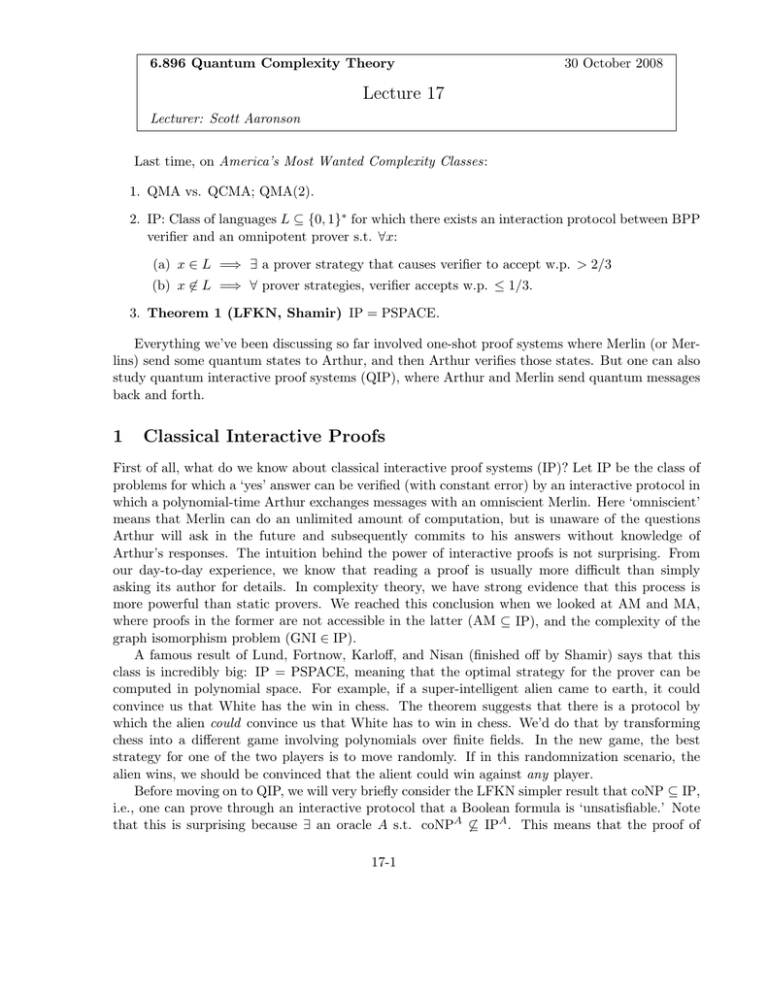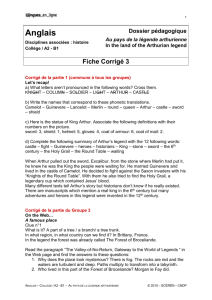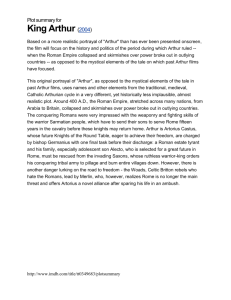Lecture 17
advertisement

6.896 Quantum Complexity Theory
30 October 2008
Lecture 17
Lecturer: Scott Aaronson
Last time, on America’s Most Wanted Complexity Classes:
1. QMA vs. QCMA; QMA(2).
2. IP: Class of languages L ⊆ {0, 1}∗ for which there exists an interaction protocol between BPP
verifier and an omnipotent prover s.t. ∀x:
(a) x ∈ L =⇒ ∃ a prover strategy that causes verifier to accept w.p. > 2/3
(b) x �∈ L =⇒ ∀ prover strategies, verifier accepts w.p. ≤ 1/3.
3. Theorem 1 (LFKN, Shamir) IP = PSPACE.
Everything we’ve been discussing so far involved one-shot proof systems where Merlin (or Mer­
lins) send some quantum states to Arthur, and then Arthur verifies those states. But one can also
study quantum interactive proof systems (QIP), where Arthur and Merlin send quantum messages
back and forth.
1
Classical Interactive Proofs
First of all, what do we know about classical interactive proof systems (IP)? Let IP be the class of
problems for which a ‘yes’ answer can be verified (with constant error) by an interactive protocol in
which a polynomial-time Arthur exchanges messages with an omniscient Merlin. Here ‘omniscient’
means that Merlin can do an unlimited amount of computation, but is unaware of the questions
Arthur will ask in the future and subsequently commits to his answers without knowledge of
Arthur’s responses. The intuition behind the power of interactive proofs is not surprising. From
our day-to-day experience, we know that reading a proof is usually more difficult than simply
asking its author for details. In complexity theory, we have strong evidence that this process is
more powerful than static provers. We reached this conclusion when we looked at AM and MA,
where proofs in the former are not accessible in the latter (AM ⊆ IP), and the complexity of the
graph isomorphism problem (GNI ∈ IP).
A famous result of Lund, Fortnow, Karloff, and Nisan (finished off by Shamir) says that this
class is incredibly big: IP = PSPACE, meaning that the optimal strategy for the prover can be
computed in polynomial space. For example, if a super-intelligent alien came to earth, it could
convince us that White has the win in chess. The theorem suggests that there is a protocol by
which the alien could convince us that White has to win in chess. We’d do that by transforming
chess into a different game involving polynomials over finite fields. In the new game, the best
strategy for one of the two players is to move randomly. If in this randomnization scenario, the
alien wins, we should be convinced that the alient could win against any player.
Before moving on to QIP, we will very briefly consider the LFKN simpler result that coNP ⊆ IP,
i.e., one can prove through an interactive protocol that a Boolean formula is ‘unsatisfiable.’ Note
that this is surprising because ∃ an oracle A s.t. coNPA �⊆ IPA . This means that the proof of
17-1
coNP ⊆ IP must be a non-relativizing proof. This is one of the few examples we have of a proof
that exploits enough about the structure of computation that they would actually fail in the real
world where there is such an oracle.
Theorem 2 (LFKN) coNP ⊆ IP.
Proof: [Sketch] The idea here is that we have some Boolean formula φ (x1 , . . . , xn ) that Merlin
wants to convince Arthur it is non-satisfiable. Here we ‘arithmetize’ the expression by replacing all
the Boolean variables with finite field elements x1 , x2 , x3 ∈ Fp , and all the Boolean operations with
arithmetic operations over Fp . For example, a 3-bit OR arithmetizes to
x1 ∨ x2 ∨ x3 = 1 − (1 − x1 ) (1 − x3 ) (1 − x3 ) ,
which is a polynomial over the field of F3 .
As as a result, our goal here is to convince Arthur that
�
p (x) = 0.
(1)
(2)
x∈{0,1}∗
x1 ,...,xn
The omnipotent Merlin can easily verify this statement is true for some Boolean string x and tell
Arthur the result. However, Arthur isn’t so gullible. He requires convincing. Instead, Merlin
performs the sum over the last n − 1 variables such that
�
q1 (x1 ) =
p (x1 , x2 , . . . , xn ) .
(3)
x2 ,...,xn
Merlin sends Arthur all the coefficients, and Arthur can check for himself that q1 (0) + q1 (1) = 0.
Arthur must verify that the Merlin has determined the above sum correctly. Arthur evaluates
q1 (x1 ) at some random x1 = r1 ∈ Fp . From this point on, Merlin must use some fixed value of x1
that Arthur has picked, and then returns
�
q2 (x2 ) =
p (r; x2 , . . . , xn )
(4)
x3 ,...,xn
for which Arthur can verify that q2 (0) + q2 (1) = q1 (r). The process iterates, and Arthur picks
another r2 ∈ Fk and Merlin returns
�
q3 (x3 ) =
p (r1 , r2 ; x3 . . . , xn ) .
(5)
x4 ,...,xn
Arthur and Merlin continue until qn (xn ) and all the values have been fixed. Arthur can check that
p (r1 , . . . , rn ) is the required value.
However, if Merlin is lying, Arthur can catch him with constant probability. To show this
we use the following fact that a d-polynomial has at most d roots (the Fundamental theorem of
algebra). If we have two d-degree polynomials that are not equal, they can only be equal on at
most d inputs. This means that the polynomials q and p can only agree on a polynomial number
of elements. Therefore, if Arthur picks a random r1 , the verified polynomial will almost certainly
disagree if Merlin is lying. s
�
17-2
2
Quantum Interactive Proofs
Just as you’d expect, one can also define QIP: Quantum Interactive Proofs. Here the prover and
verifier can exchange quantum messages, and the prover is limited only by the laws of quantum
physics. The protocol is show in Figure 1 below.
|q0 i = |Merlini
|q1 i = |Sharedi
UM1
|q2 i = |Arthur ∈ BQPi
UM2
UA1
Figure 1: Merlin-Arthur QIP protocol using a polynomial number of gates. To simplify the illus­
tration, each set of private and shared qubits used by Merlin and Arthur are tensored together a
p(n)
polynomial number of times. For example, |q� = ⊗i |i�.
QIP is defined as the class of languages L ⊆ {0, 1}∗ for which there exists an interaction protocol
between BQP verifier (Arthur) and an omnipotent prover (Merlin) s.t. ∀x:
1. x ∈ L =⇒ ∃ M1 and M2 causing Arthur to accept w.p. > 2/3
2. x �∈ L =⇒ ∀ M1 and M2 Arthur accepts w.p. ≤ 1/3.
Certainly IP ⊆ QIP; that is, quantum interactive proof systems can simulate classical ones.
Thus PSPACE ⊆ QIP. However, it turns out that something new and extremely interesting
happens in the case of quantum interactive protocols.
Theorem 3 (Kitaev,Watrous00) Any QIP protocol can be made three-round. In other words,
all QIP rounds are given by QIP(1) = QMA, QAM ⊆ QIP(2), and QIP(3) = QIP.
Proof: [Sketch] To illustrate, lets just show how to do PSPACE with three rounds (PSPACE ⊆
QIP (3)). Assume without loss of generality that Arthurs messages to Merlin are all just uniform
random bits. Then Merlin can send Arthur a (claimed) superposition over all possible conversations
that they could have had:
1
√
2T
�
|a1 � |a2 � · · · |aT � |m1 � |m2 � · · · |mT �
(6)
a1 ,...,aT
For reasons we’ll see later, Merlin also keeps a copy of the |aT � registers for himself. Arthur can
now check, in superposition, whether or not the conversation would have caused him to accept. The
trouble is, what if Merlin cheated by picking |aT �’s that werent truly random—and were instead
concentrated on the tiny fraction where he can get away with lying?
Arthur needs to verify that the |aT �’s are random. To do so, he first picks a random time
step t, and sends Merlin the |mu � for all u > t. Using his copy of the |aT � registers, Merlin then
uncomputes those |mu �. Finally, Merlin sends Arthur his |aT � registers. Arthur is now able to
measure the |au � registers with u > t in the Hadamard basis, and check whether the messages
17-3
supposedly from him were really uniformly random. If Merlin was honest, Arthur will now accept
with probability 1. The nontrivial thing you have to prove is that if Merlin cheated, Arthur will
detect it with 1/poly (n) probability. Furthermore, he can amplify that probability by running the
protocol polynomially many times in parallel.
�
It’s important to note that Merlin will be unable to suddenly swap out his qubits with some
other qubits and expect the entanglement he shares with Arthur to remain intact. This fact,
known as the ‘monogamy of entanglement,’ is related to the differences between correlation and
entanglement. Here, consider three classical bits x, y, and z, and the correlation x ∼ y ∼ z. By
transitivity, if x ∼ y and y ∼ z, x ∼ z. However, if two variables x and y are entangled, it is not
possible to entangle a third variable z with x. This can be shown by taking the partial trace over
a sample three-way entangled GHZ state,
1
|xyz� = √ (|000� + |111�)
2
(7)
which results in x and x having statistically-independent distributions.
The remaining question here is the upper bound to QIP. Kitaev and Watrous also showed that
QIP ⊆ EXP. They did this by expressing the problem of finding the best possible strategy for
the prover as an exponentially-large, semi-definite programming (SDP) problem. SDP is known
to be solvable in polynomial time. Let’s see how they did this: SDP is basically the problem
of finding positive definite matrices that satisfy a set of linear constraints. A general quantum
state (i.e. a mixed state) is just a Hermitian positive definite matrix with trace 1. The trace 1
and Hermitian are linear constraints. So, the problem of finding N -dimensional quantum mixed
states that satisfy a bunch of linear constraints is an SDP. The question now becomes, how can
we formulate the problem of finding the optimal strategy for Merlin in a quantum interactive
protocol, as a problem of finding mixed states that satisfy linear constraints? Imagine the circuit
depicted in Figure 1 that relates mixed states ρ and σ through the QIP unitary protocol. The
problem is to find states ρ,σ such that
� ρ is
�a valid initial
� −1state,
� σ is a final state that accepts
−1 = Tr
with maximum
probability,
and
Tr
U
ρU
W
σW
. Here we’re using the fact that
M
�
�
� −1
�M
−1
if TrM U ρU
= TrM W σW , then there must exist a unitary transformation on Merlin’s
registers only that transforms U ρU −1 to W −1 σW .
To this day, we dont know exactly where QIP sits between PSPACE and EXP.
2.1
Multi-prover QIP
Finally, many quantum computing people lately have been interested in multi-prover quantum
interactive proof systems. In the classical world, putting two people in separate rooms to interrogate
them often lets you learn more than if the people could talk to each other. Let MIP be the class
of problems for which a ‘yes’ answer can be efficiently verified with the help of two or more noncommunicating provers. Babai, Fortnow, and Lund showed that MIP = NEXP, whereas IP only
equals PSPACE. In the quantum world, though, we don’t know whether QMIP contains NEXP.
What do you think the difficulty is? The provers could be entangled with each other! And indeed,
Cleve, Hoyer, Toner, Watrous 2004 gave examples of protocols that are sound when the provers
don’t share entanglement, but become unsound when they did.
Nor, embarrassing as it is to admit, do we know any upper bound whatsoever on QMIP—the
reason being that we don’t know a priori how much entanglement the provers need in their strategy.
17-4
Doherty, Liang, Toner, Wehner 2008 show that if a finite amount of entanglement suffices, then
all QMIP languages are at least recursive. (On the other hand, we still dont know if there are
situations where a literally infinite amount of entanglement is needed to play optimally!)
Just as BQP is contained in PP, so BQPSPACE is contained in PPSPACE. But Ladner proved
that PPSPACE = PSPACE, using the same ideas as in Savitch’s Theorem. Hence BQPSPACE =
PSPACE.
3
The Future
Quantum computing with closed time-like curves.
17-5
MIT OpenCourseWare
http://ocw.mit.edu
6.845 Quantum Complexity Theory
Fall 2010
For information about citing these materials or our Terms of Use, visit: http://ocw.mit.edu/terms.




